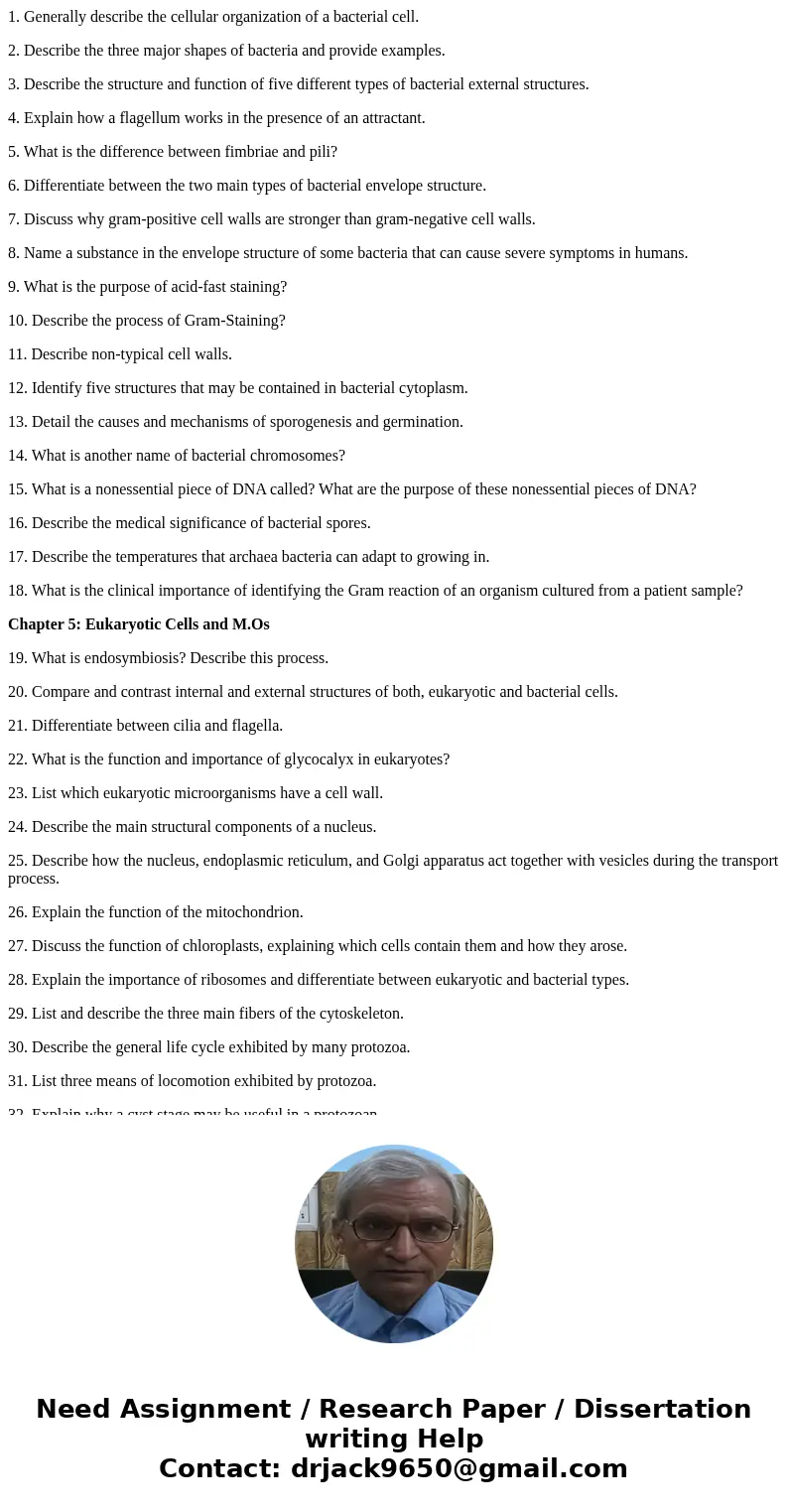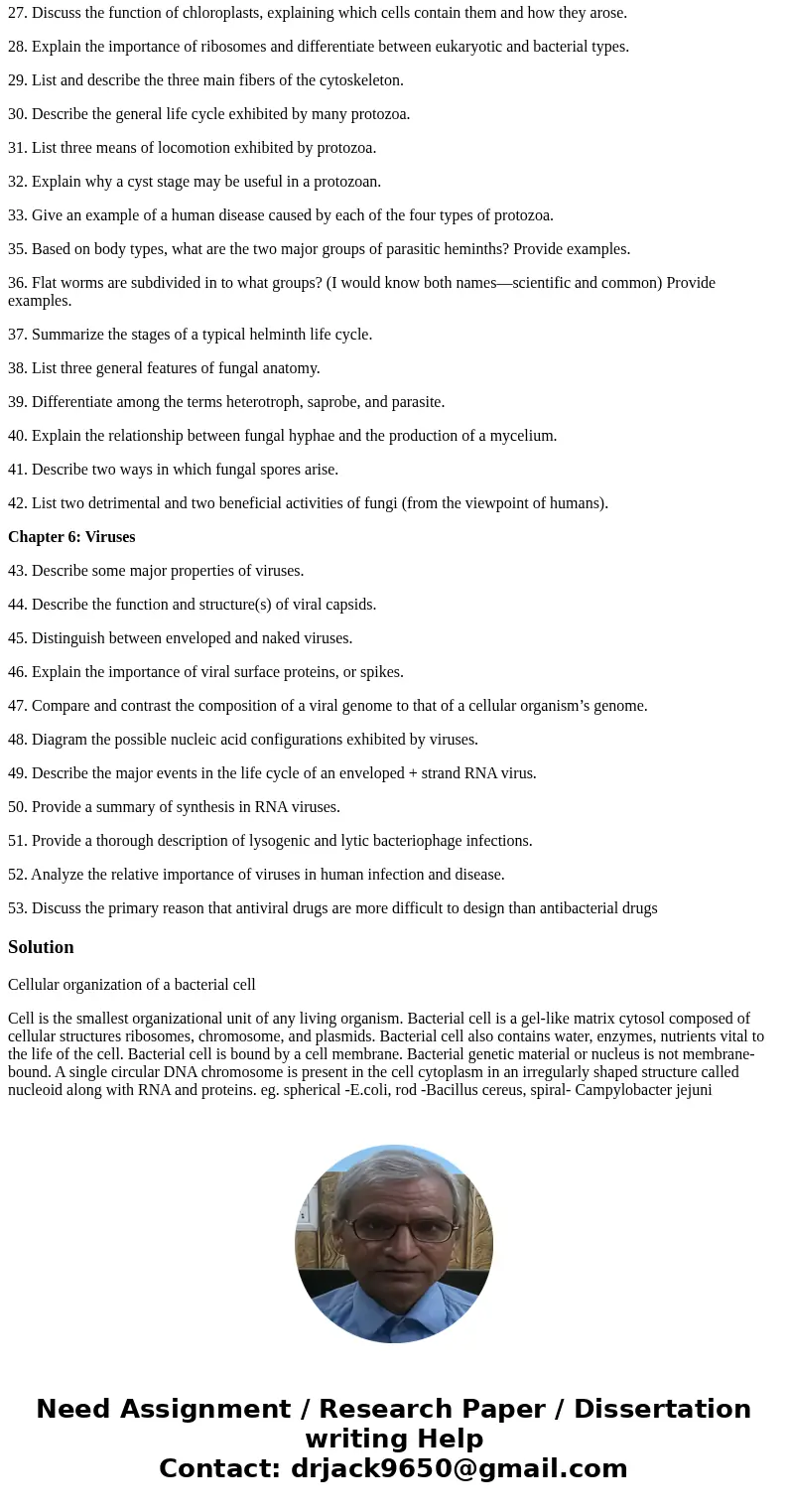1 Generally describe the cellular organization of a bacteria
1. Generally describe the cellular organization of a bacterial cell.
2. Describe the three major shapes of bacteria and provide examples.
3. Describe the structure and function of five different types of bacterial external structures.
4. Explain how a flagellum works in the presence of an attractant.
5. What is the difference between fimbriae and pili?
6. Differentiate between the two main types of bacterial envelope structure.
7. Discuss why gram-positive cell walls are stronger than gram-negative cell walls.
8. Name a substance in the envelope structure of some bacteria that can cause severe symptoms in humans.
9. What is the purpose of acid-fast staining?
10. Describe the process of Gram-Staining?
11. Describe non-typical cell walls.
12. Identify five structures that may be contained in bacterial cytoplasm.
13. Detail the causes and mechanisms of sporogenesis and germination.
14. What is another name of bacterial chromosomes?
15. What is a nonessential piece of DNA called? What are the purpose of these nonessential pieces of DNA?
16. Describe the medical significance of bacterial spores.
17. Describe the temperatures that archaea bacteria can adapt to growing in.
18. What is the clinical importance of identifying the Gram reaction of an organism cultured from a patient sample?
Chapter 5: Eukaryotic Cells and M.Os
19. What is endosymbiosis? Describe this process.
20. Compare and contrast internal and external structures of both, eukaryotic and bacterial cells.
21. Differentiate between cilia and flagella.
22. What is the function and importance of glycocalyx in eukaryotes?
23. List which eukaryotic microorganisms have a cell wall.
24. Describe the main structural components of a nucleus.
25. Describe how the nucleus, endoplasmic reticulum, and Golgi apparatus act together with vesicles during the transport process.
26. Explain the function of the mitochondrion.
27. Discuss the function of chloroplasts, explaining which cells contain them and how they arose.
28. Explain the importance of ribosomes and differentiate between eukaryotic and bacterial types.
29. List and describe the three main fibers of the cytoskeleton.
30. Describe the general life cycle exhibited by many protozoa.
31. List three means of locomotion exhibited by protozoa.
32. Explain why a cyst stage may be useful in a protozoan.
33. Give an example of a human disease caused by each of the four types of protozoa.
35. Based on body types, what are the two major groups of parasitic heminths? Provide examples.
36. Flat worms are subdivided in to what groups? (I would know both names—scientific and common) Provide examples.
37. Summarize the stages of a typical helminth life cycle.
38. List three general features of fungal anatomy.
39. Differentiate among the terms heterotroph, saprobe, and parasite.
40. Explain the relationship between fungal hyphae and the production of a mycelium.
41. Describe two ways in which fungal spores arise.
42. List two detrimental and two beneficial activities of fungi (from the viewpoint of humans).
Chapter 6: Viruses
43. Describe some major properties of viruses.
44. Describe the function and structure(s) of viral capsids.
45. Distinguish between enveloped and naked viruses.
46. Explain the importance of viral surface proteins, or spikes.
47. Compare and contrast the composition of a viral genome to that of a cellular organism’s genome.
48. Diagram the possible nucleic acid configurations exhibited by viruses.
49. Describe the major events in the life cycle of an enveloped + strand RNA virus.
50. Provide a summary of synthesis in RNA viruses.
51. Provide a thorough description of lysogenic and lytic bacteriophage infections.
52. Analyze the relative importance of viruses in human infection and disease.
53. Discuss the primary reason that antiviral drugs are more difficult to design than antibacterial drugs
Solution
Cellular organization of a bacterial cell
Cell is the smallest organizational unit of any living organism. Bacterial cell is a gel-like matrix cytosol composed of cellular structures ribosomes, chromosome, and plasmids. Bacterial cell also contains water, enzymes, nutrients vital to the life of the cell. Bacterial cell is bound by a cell membrane. Bacterial genetic material or nucleus is not membrane-bound. A single circular DNA chromosome is present in the cell cytoplasm in an irregularly shaped structure called nucleoid along with RNA and proteins. eg. spherical -E.coli, rod -Bacillus cereus, spiral- Campylobacter jejuni


 Homework Sourse
Homework Sourse